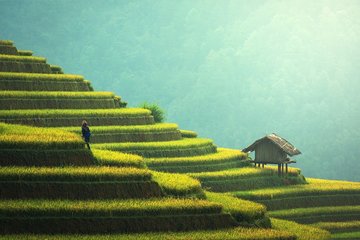Results for "agriculture"
8 Results
Agriculture
In natural selection, those variations in the genotype (the entire complex of genes inherited from both parents) that increase an organism’s chances of survival and procreation are preserved and multiplied from generation to generation at the expense of less advantageous variations. Evolution often occurs as a consequence of this process.
By:
rupali
Tuesday, Sep 28, 2021
EDUCATION

Leave a comment
Sri Lanka - Agriculture
Agriculture is the most important sector of the Sri Lankan economy. Even though its contribution to the gross domestic product declined substantially during the past 3 decades (from 30 percent in 1970 to 21 percent in 2000), it is the most important source of employment for the majority of the Sri Lankan workforce. Approximately 38 percent of the total labor force was engaged in agriculture in 1999. In the subsistence sector, rice is the main crop and farming rice is the most important economic activity for the majority of the people living in rural areas. During the last 5 decades the rice sector grew rapidly and output more than tripled, reaching the highest ever output of 2.9 million metric tons in 1999. Increases in the area under cultivation, and improved productivity due to the modernization of agriculture are the main reasons for an increase in production. The rehabilitation of Sri Lanka's extensive ancient irrigation network and massive new investment in construction and maintenance of irrigation infrastructure led to a large increase in the area under rice cultivation. Between 1960-2000, the area used to grow rice increased 6 times to 546,249 hectares. The modernization of farming methods, such as the use of high-yielding seeds, tractors, and chemical fertilizers also led to increased productivity in the rice sector. Between 1960-1999, rice yield per hectare doubled from 1,877 kilograms to 3,672 kilograms. In addition to rice, various other food crops are produced for local consumption. They include yams, pulses, grains, vegetables, and fruits. Most of these crops are cultivated in family gardens, except for potatoes and sugar. Sugar cane is cultivated in the dry zone, and Sri Lanka produces only 15 percent of what it consumes domestically.Read more: https://www.nationsencyclopedia.com/economies/Asia-and-the-Pacific/Sri-Lanka-AGRICULTURE.html#ixzz6vrxdyz7V
By:
Anne miller New vijayalaxmi santosh mhetre mali
Thursday, May 27, 2021
AGRI-FOOD SYSTEMS

Leave a comment
Importance and Key Points Of Crop Production and Management
Agriculture is intertwined with many other processes such as - cultivation, preparation of soil, sowing, irrigation, and so on. A farmer is involved in all these processes. He prepares the soil, sows the seeds, adds manure, irrigates, and harvests.
the production and management of crops is an important aspect to ensure optimal productivity in the fields. The major agricultural practices involved in crop production and management are listed below: The soil is loosened and tilted before the seeds are sown
The entire world depends on agriculture for its food. Therefore, it is very important to produce and store the harvested crops carefully.
The soil should be loosened and aerated properly during crop production.
Manures and fertilizers need to be added carefully. Too much fertilizer damages the soil while too little makes the crop deficient in nutrients.
The crops should be irrigated periodically.
The unwanted plants should be removed from the cultivated fields. These plants absorb the nutrients provided to the crop and obstruct their growth and development.
The matured crops are harvested mechanically or manually.
The harvested grains are dried and stored to protect them from pests and pathogens.Agriculture provides employment either in crops and livestock productions thus improving the family's standard of living and reducing poverty level.
By:
rupali
Wednesday, May 19, 2021
AGRI-FOOD SYSTEMS
+1
Leave a comment
Agriculture
Agriculture is the art and science of cultivating the soil, growing crops and raising livestock. It includes the preparation of plant and animal products for people to use and their distribution to markets. Agriculture provides most of the world’s food and fabrics. Cotton, wool, and leather are all agricultural products.
Agriculture, with its allied sectors, is unquestionably the largest livelihood provider in India, more so in the vast rural areas. It also contributes a significant figure to the Gross Domestic Product (GDP). Sustainable agriculture, in terms of food security, rural employment, and environmentally sustainable technologies such as soil conservation, sustainable natural resource management and biodiversity protection, are essential for holistic rural development. Indian agriculture and allied activities have witnessed a green revolution, a white revolution, a yellow revolution and a blue revolution.This section provides the information on agriculture produces; machineries, research etc. Detailed information on the government policies, schemes, agriculture loans, market prices, animal husbandry, fisheries, horticulture, loans & credit, sericulture etc. is also available.
Agriculture is the science, art and practice of cultivating plants and livestock. Agriculture was the key development in the rise of sedentary human civilization, whereby farming of domesticated species created food surpluses that enabled people to live in cities. The history of agriculturebegan thousands of years ago. After gathering wild grains beginning at least 105,000 years ago, nascent farmers began to plant them around 11,500 years ago. Pigs, sheep, and cattle were domesticated over 10,000 years ago
By:
rupali
Wednesday, May 19, 2021
AGRI-FOOD SYSTEMS
+1
Leave a comment
Agri and food
AGRICULTURE AND FOOD
As agricultural goods progress from field to fork they require attention, tracking and integrity. We offer an end-to-end supply chain range of services that reduce risk, ensure quality and improve productivity.
By:
Lorell Sandi
Wednesday, May 12, 2021
YOUTH EMPOWERMENT
+1
Leave a comment
Agri and food
AGRICULTURE AND FOOD
As agricultural goods progress from field to fork they require attention, tracking and integrity. We offer an end-to-end supply chain range of services that reduce risk, ensure quality and improve productivity.
By:
Lorell Sandi
Wednesday, May 12, 2021
YOUTH EMPOWERMENT
Leave a comment
Agri and food Scholar
Agriculture is the science and art of cultivating plants and livestock.[1] Agriculture was the key development in the rise of sedentary human civilization, whereby farming of domesticated species created food surpluses that enabled people to live in cities. The history of agriculture began thousands of years ago. After gathering wild grains beginning at least 105,000 years ago, nascent farmers began to plant them around 11,500 years ago. Pigs, sheep and cattle were domesticated over 10,000 years ago. Plants were independently cultivated in at least 11 regions of the world. Industrial agriculture based on large-scale monoculture in the twentieth century came to dominate agricultural output, though about 2 billion people still depended on subsistence agriculture into the twenty-first.
By:
Ameliya
Wednesday, May 12, 2021
AGRI-FOOD SYSTEMS
+4

Leave a comment
venture capital :
Agriculture is the science and art of cultivating plants and livestock.[1] Agriculture was the key development in the rise of sedentary human civilization, whereby farming of domesticated species created food surpluses that enabled people to live in cities. The history of agriculture began thousands of years ago. After gathering wild grains beginning at least 105,000 years ago, nascent farmers began to plant them around 11,500 years ago. Pigs, sheep and cattle were domesticated over 10,000 years ago. Plants were independently cultivated in at least 11 regions of the world. Industrial agriculture based on large-scale monoculture in the twentieth century came to dominate agricultural output, though about 2 billion people still depended on subsistence agriculture into the twenty-first.
By:
Ameliya
Wednesday, May 12, 2021
AGRI-FOOD SYSTEMS
+4



Leave a comment